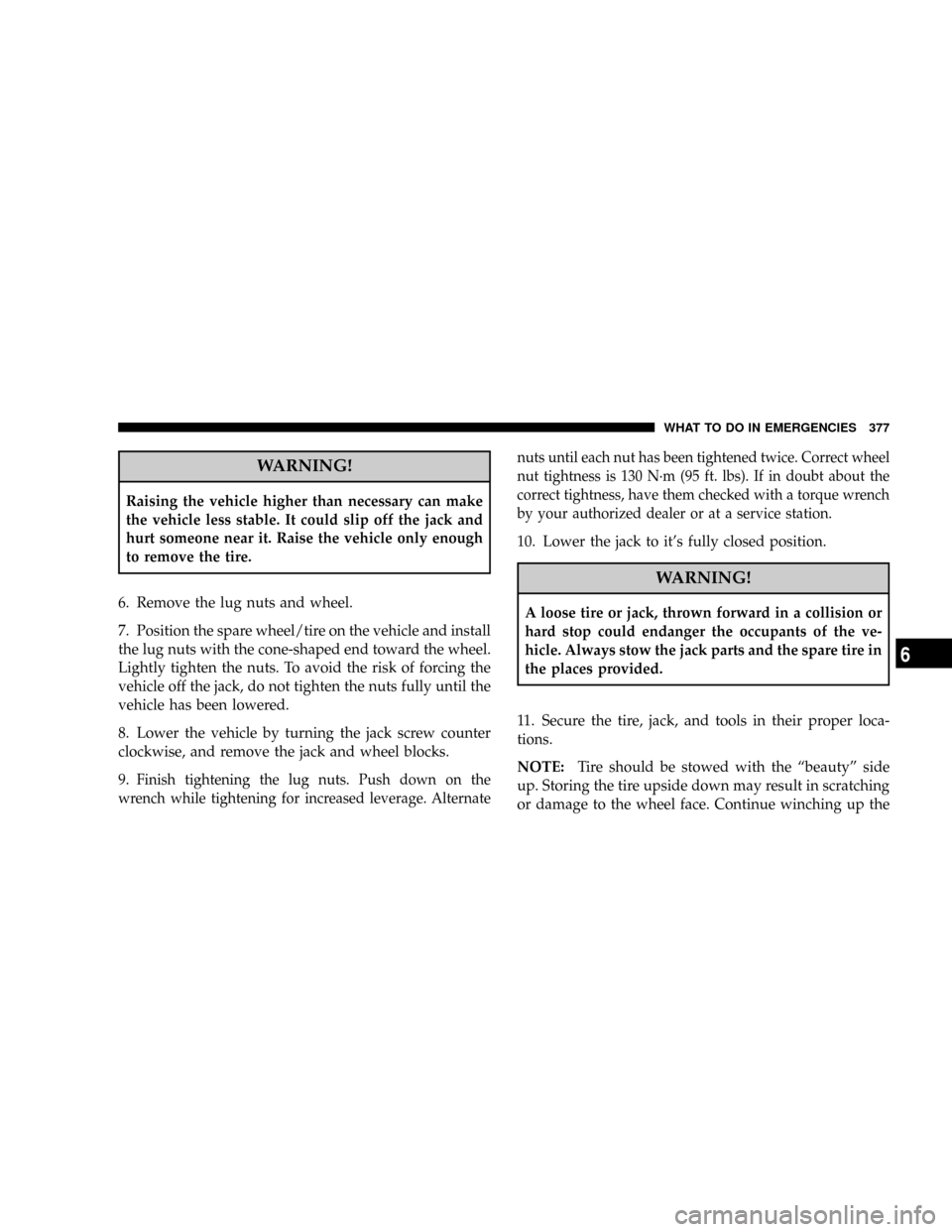2008 JEEP GRAND CHEROKEE wheel torque
[x] Cancel search: wheel torquePage 139 of 490

WARNING!
ABS (Anti-Lock Brake System) cannot prevent the
natural laws of physics from acting on the vehicle,
nor can it increase the traction afforded by prevailing
road conditions. ABS cannot prevent accidents, in-
cluding those resulting from excessive speed in
turns, driving on very slippery surfaces, or hydro-
planing. Only a safe, attentive, and skillful driver can
prevent accidents. The capabilities of an ABS-
equipped vehicle must never be exploited in a reck-
less or dangerous manner which could jeopardize the
user's safety or the safety of others.
TCS (Traction Control System)
This system monitors the amount of wheel spin of each of
the driven wheels. If wheel spin is detected, brake
pressure is applied to the slipping wheel(s) and engine
power is reduced to provide enhanced acceleration and
stability. A feature of the TCS system functions similar to
a limited slip differential and controls the wheel spin
across a driven axle. If one wheel on a driven axle is
spinning faster than the other, the system will apply the
brake of the spinning wheel. This will allow more engine
torque to be applied to the wheel that is not spinning.
This feature remains active even if TCS and ESP are in
either the ªPartial Offº or ªFull Offº modes. Refer to ªESP
(Electronic Stability Program)º in this section for more
information.
UNDERSTANDING THE FEATURES OF YOUR VEHICLE 139
3
Page 292 of 490
![JEEP GRAND CHEROKEE 2008 WK / 3.G Owners Manual NOTE:The torque converter clutch will not engage
until the transmission fluid and engine coolant are warm
[usually after 1-3 miles (1.6 - 4.8 km) of driving]. Because
the engine speed is higher when t JEEP GRAND CHEROKEE 2008 WK / 3.G Owners Manual NOTE:The torque converter clutch will not engage
until the transmission fluid and engine coolant are warm
[usually after 1-3 miles (1.6 - 4.8 km) of driving]. Because
the engine speed is higher when t](/manual-img/16/7091/w960_7091-291.png)
NOTE:The torque converter clutch will not engage
until the transmission fluid and engine coolant are warm
[usually after 1-3 miles (1.6 - 4.8 km) of driving]. Because
the engine speed is higher when the torque converter
clutch is not engaged, it may seem as if the transmission
is not shifting into Overdrive when cold. This is normal.
Manually shifting (using the ERS shift control) between 4
(direct gear) and 5/D (Overdrive gear) positions will
demonstrate that the transmission is able to shift into and
out of Overdrive.
NOTE:If the vehicle has not been driven in several
days, the first few seconds of operation after shifting the
transmission into gear may seem sluggish. This is due to
the fluid partially draining from the torque converter into
the transmission. This condition is normal and will not
cause damage to the transmission. The torque converter
will refill within five seconds of shifting from Park into
any other gear position.Rocking the Vehicle
If the vehicle becomes stuck in snow, sand, or mud, it can
often be moved by a rocking motion. Move the gear
selector rhythmically between D (Drive) and R (Reverse),
while applying slight pressure to the accelerator.
NOTE:The Electronic Stability Program (ESP) and
Traction Control (if equipped) should be turned OFF
before attempting to rock the vehicle. Refer to ªElectronic
Brake Control Systemº in Section 3 of this manual.
The least amount of accelerator pedal pressure to main-
tain the rocking motion without spinning the wheels or
racing the engine is most effective. Racing the engine or
spinning the wheels, due to the frustration of not freeing
the vehicle, may lead to transmission overheating and
failure. Allow the engine to idle with the transmission
selector in N (Neutral) for at least one minute after every
292 STARTING AND OPERATING
Page 293 of 490

five rocking-motion cycles. This will minimize overheat-
ing and reduce the risk of transmission failure during
prolonged efforts to free a stuck vehicle.
CAUTION!
When ªrockingº a stuck vehicle by moving between
ªFirstº and R (Reverse), do not spin the wheels faster
than 15 mph (24 km/h), or drivetrain damage may
result.
FOUR-WHEEL DRIVE OPERATION
Quadra-Trac ITOperating
Instructions/Precautions Ð If Equipped
The Quadra-Trac Itis a single speed (HI range only)
transfer case which provides convenient full-time
4±wheel drive. No driver interaction is required. This
transfer case divides engine torque almost evenly with 48percent of engine torque to the front axle and 52 percent
of engine torque to the rear axle. The Brake Traction
Control System (BTC), which combines standard ABS
and Traction Control, provides resistance to any wheel
that is slipping to allow additional torque transfer to
wheels with traction.
NOTE:The Quadra-Trac Itsystem is not appropriate
for conditions where LOW range is recommended. Refer
to ªOff-Road Driving Tipsº in this section.
Quadra-Trac IITOperating
Instructions/Precautions Ð If Equipped
The Quadra-Trac IIttransfer case is fully automatic in the
normal driving 4 HI mode. The Quadra-Trac IIttransfer
case provides three mode positions Ð four wheel drive
high range, neutral, and four wheel drive low range.
This transfer case is fully automatic in the 4 HI mode.
This transfer case divides engine torque almost evenly
with 48 percent of engine torque to the front axle and 52
STARTING AND OPERATING 293
5
Page 294 of 490

percent of engine torque to the rear axle. When speed
differences are increased between the front and rear drive
shafts, the transfer case can transmit up to 100 percent of
available engine torque to the front or rear drive shafts.
When additional traction is required, the 4 LOW position
can be used to lock the front and rear driveshafts together
and force the front and rear wheels to rotate at the same
speed. The 4 LOW position is intended for loose, slippery
road surfaces only. Driving in the 4 LOW position on dry
hard surfaced roads may cause increased tire wear and
damage to driveline components.
When operating your vehicle in 4 LOW, the engine speed
is approximately three times that of the 4 HI position at a
given road speed. Take care not to overspeed the engine
and do not exceed 25 mph (40 km/h).Proper operation of four wheel drive vehicles depends on
tires of equal size, type, and circumference on each
wheel. Any difference will adversely affect shifting and
cause damage to the transfer case.
Because four wheel drive provides improved traction,
there is a tendency to exceed safe turning and stopping
speeds. Do not go faster than road conditions permit.
294 STARTING AND OPERATING
Page 299 of 490

Quadra-Drive IITSystem Ð If Equipped
The optional Quadra-Drive IItSystem features three
torque transfer couplings. The couplings include ELSD
(Electronic Limited Slip Differential) front and rear axles
and Quadra-Trac IIttransfer case. The optional ELSD
axles are fully automatic and require no driver input to
operate. Under normal driving conditions the units func-
tion as standard axles balancing torque evenly between
left and right wheels. With a traction difference between
left and right wheels the coupling will sense a speed
difference. As one wheel begins to spin faster than the
other, torque will automatically transfer from the wheel
that has less traction to the wheel that has traction. While
the transfer case and axle couplings differ in design, their
operation is similar. Follow the Quadra-Trac IIttransfer
case shifting information, preceding this section, for
shifting this system.
ON-ROAD DRIVING TIPS
Utility vehicles have higher ground clearance and a
narrower track to make them capable of performing in a
wide variety of off-road applications. Specific design
characteristics give them a higher center of gravity than
ordinary cars.
An advantage of the higher ground clearance is a better
view of the road, allowing you to anticipate problems.
They are not designed for cornering at the same speeds as
conventional 2-wheel drive vehicles any more than low-
slung sports cars are designed to perform satisfactorily in
off-road conditions. If at all possible, avoid sharp turns or
abrupt maneuvers. As with other vehicles of this type,
failure to operate this vehicle correctly may result in loss
of control or vehicle rollover.
STARTING AND OPERATING 299
5
Page 303 of 490

After Driving Off-Road
Off-road operation puts more stress on your vehicle than
does most on-road driving. After going off-road it is
always a good idea to check for damage. That way you
can get any problems taken care of right away and have
your vehicle ready when you need it.
²Completely inspect the underbody of your vehicle.
Check tires, body structure, steering, suspension, and
exhaust system for damage.
²Check threaded fasteners for looseness, particularly on
the chassis, drivetrain components, steering, and sus-
pension. Retighten them, if required, and torque to the
values specified in the Service Manual.
²Check for accumulations of plants or brush. These
things could be a fire hazard. They might hide damage
to fuel lines, brake hoses, axle pinion seals, and
propeller shafts.
²After extended operation in mud, sand, water, or
similar dirty conditions, have brake rotors, wheels,
brake linings, and axle yokes inspected and cleaned as
soon as possible.
WARNING!
Abrasive material in any part of the brakes may cause
excessive wear or unpredictable braking. You might
not have full braking power when you need it to
prevent an accident. If you have been operating your
vehicle in dirty conditions, get your brakes checked
and cleaned as necessary.
²If you experience unusual vibration after driving in
mud, slush or similar conditions, check the wheels for
impacted material. Impacted material can cause a
wheel imbalance and freeing the wheels of it will
correct the situation.
STARTING AND OPERATING 303
5
Page 377 of 490

WARNING!
Raising the vehicle higher than necessary can make
the vehicle less stable. It could slip off the jack and
hurt someone near it. Raise the vehicle only enough
to remove the tire.
6. Remove the lug nuts and wheel.
7. Position the spare wheel/tire on the vehicle and install
the lug nuts with the cone-shaped end toward the wheel.
Lightly tighten the nuts. To avoid the risk of forcing the
vehicle off the jack, do not tighten the nuts fully until the
vehicle has been lowered.
8. Lower the vehicle by turning the jack screw counter
clockwise, and remove the jack and wheel blocks.
9.
Finish tightening the lug nuts. Push down on the
wrench while tightening for increased leverage. Alternatenuts until each nut has been tightened twice. Correct wheel
nut tightness is 130 N´m (95 ft. lbs). If in doubt about the
correct tightness, have them checked with a torque wrench
by your authorized dealer or at a service station.
10. Lower the jack to it's fully closed position.
WARNING!
A loose tire or jack, thrown forward in a collision or
hard stop could endanger the occupants of the ve-
hicle. Always stow the jack parts and the spare tire in
the places provided.
11. Secure the tire, jack, and tools in their proper loca-
tions.
NOTE:Tire should be stowed with the ªbeautyº side
up. Storing the tire upside down may result in scratching
or damage to the wheel face. Continue winching up the
WHAT TO DO IN EMERGENCIES 377
6
Page 487 of 490

Tip Start.............................. 280
Tire and Loading Information Placard......... 314
Tire Identification Number (TIN)............. 313
Tire Markings.......................... 310
Tire Safety Information.................... 310
Tires ............................70,318,466
Air Pressure.......................... 319
Alignment and Balance.................. 324
Chains.............................. 325
Changing............................ 372
General Information.................... 318
High Speed.......................... 321
Inflation Pressures..................... 319
Jacking............................. 372
Life of Tires.......................... 323
Load Capacity.....................314,315
Pressure Monitor System (TPMS)........... 326
Pressure Warning Light.................. 191
Quality Grading....................... 466Radial.............................. 321
Replacement......................... 323
Rotation............................. 325
Safety............................70,310
Sizes............................... 311
Spare Tire........................... 373
Spinning............................ 321
Tread Wear Indicators................... 322
Wheel Mounting....................... 377
Tongue Weight/Trailer Weight.............. 357
Torque Converter Clutch.................. 291
Tow Hooks, Emergency................... 381
Tow/Haul Indicator Light................. 193
Towing............................351,382
Disabled Vehicle....................... 382
Guide.............................. 355
Recreational.......................... 364
Weight.............................. 355
Traction Control......................... 139
INDEX 487
10